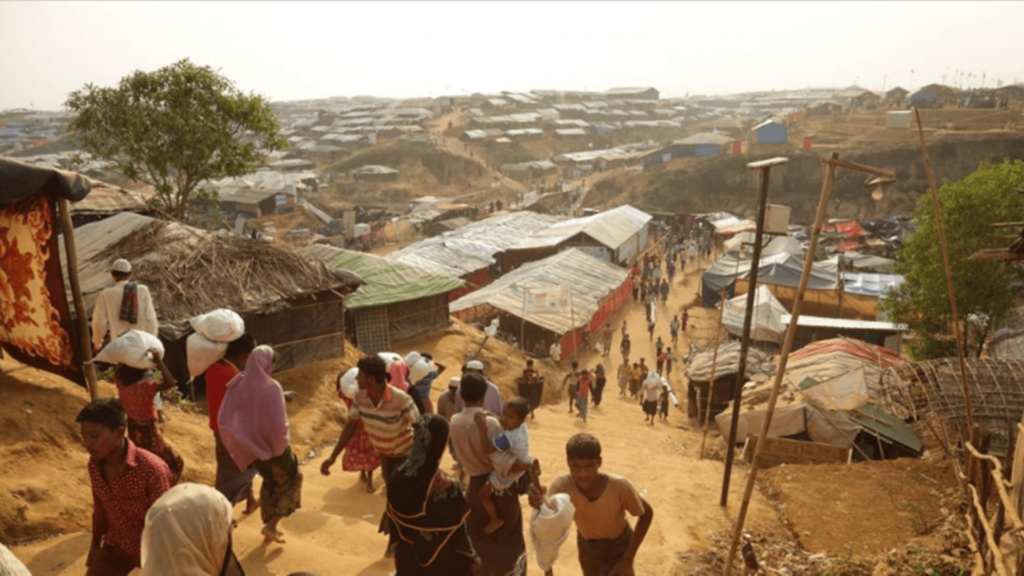
The Rohingya Crisis in 90 Seconds
Overview
The Rohingya people are a stateless Muslim minority in the western Myanmar state of Rakhine. They have been forced out of Myanmar (also known as Burma) by violence and racism for more than 20 years. Myanmar’s government refuses to recognize the Rohingya people as one of the 135 official minority groups in the country, denying them citizenship as long as they identify as Rohingya. The most recent crisis began in August 2017 when hundreds of thousands of Rohingya people — more than half of whom were children —fled violence against them by seeking refuge in neighboring Bangladesh.
Currently estimated to include a million people, most of these refugees have settled in the Cox’s Bazar region of Bangladesh, living in sprawling refugee camps. The largest camp houses as many people as the City of Baltimore but in a space occupying only five square miles (13 square kilometers). These temporary settlements were put up very quickly, leading to concerns about WASH (Water, Sanitation and Hygiene), shelter and safety for women and girls.
The seasonal monsoons arrived in the Cox’s Bazar region bringing flash floods and soil erosion that has made the living conditions in refugee camps more precarious. It caused significant damage to shelters and infrastructure in refugee camps that affected more than 4,500 people. The response and reconstruction was handled by refugees in the camps with support from UNHCR and other partners. Refugee volunteers were empowered to take the lead in the emergency response, performing water rescues and evacuating people from affected structures.
The arrival of COVID-19 in the Cox’s Bazar area has raised concerns about the health of the Rohingya refugees occupying the settlements. The tight spaces, accompanied by the lack of access to basic services, especially healthcare, leave those residing in Cox’s Bazar especially vulnerable to the virus. As a result of these concerns, Bangladesh imposed a complete lockdown on Cox’s Bazar with only critical aid and healthcare staff being allowed to enter and exit the area. Aid agencies working in Cox’s Bazar have mobilized Rohingya volunteers to support hygiene and prevention messaging in order to avoid the spread of COVID-19.
Despite the best efforts of healthcare organizations, aid agencies and Rohingya volunteers, the first case of COVID-19 in Cox’s Bazar was confirmed on May 15, 2020, with the first death being confirmed on May 30. As of July 12, 57 cases of COVID-19 have been confirmed in Rohingya camps with another 3,000 in the surrounding Cox’s Bazar region. With the support of the World Health Organization (WHO), local health services are ramping up testing capacity to 2,000 tests per day.
Critical Needs
On April 30, 2020 the United Nations Refugee Agency (UNHCR) released their operational dashboard indicating their progress toward their goals for the 2020 Rohingya refugee response. Some of the activities identified as being well below the 2020 target include:
- Sexual and Gender-Based Violence Prevention and Response: The United Nations (UN) is working to form at least 150 community-based committees or groups to help prevent and respond to sexual and gender-based violence in the Rohingya refugee community. Only 12 groups had been created as of April 30. These committees and groups enable community members to intervene before violence happens and to provide assistance for those who have experienced violence. To ensure the safety of Rohingya women and girls, support for forming and educating these committees and groups is crucial.
- Water, Sanitation and Hygiene Facilities: The COVID-19 public health concerns and lockdown has resulted in the construction of far fewer WASH facilities. This means that there is less access to clean water, latrines and bathing facilities for the entire community. Support for the rapid construction of these facilities when it is safe to do so is key to helping prevent further outbreaks of COVID-19 and other infectious diseases.
- Unrestricted Financial Support to Responding Agencies: In addition to the UN, there are at least 27 operational nongovernmental organizations (NGOs the UNHCR refers to as partners) working to support UNHCR during this complex humanitarian emergency. With much of the philanthropic support and attention of the world focused on COVID-19, support for ongoing humanitarian emergencies is key. The UN’s Inter Sector Coordination Group released a funding update on July 20 showing that the response plan’s appeal for $1.06 billion was only 39 percent funded with only $409 million received to date.
- Support for Camp and Building Design and Construction: The vast majority of these structures were built without planning or preparation to ensure their long-term viability. As a result, they are susceptible to flooding and unstable slopes, particularly during the monsoon season. UNHCR is working with other agencies to ensure the long-term stability of these structures as there is no end in sight to this complex humanitarian emergency.
CDP / Balkantimes.press
